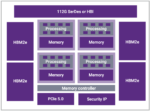You are currently viewing SemiWiki as a guest which gives you limited access to the site. To view blog comments and experience other SemiWiki features you must be a registered member. Registration is fast, simple, and absolutely free so please,
join our community today!
WP_Term Object
(
[term_id] => 6435
[name] => AI
[slug] => artificial-intelligence
[term_group] => 0
[term_taxonomy_id] => 6435
[taxonomy] => category
[description] => Artificial Intelligence
[parent] => 0
[count] => 734
[filter] => raw
[cat_ID] => 6435
[category_count] => 734
[category_description] => Artificial Intelligence
[cat_name] => AI
[category_nicename] => artificial-intelligence
[category_parent] => 0
[is_post] =>
)
Convergence of Edge Computing, Machine Vision and 5G-Connected Vehicles
Today’s societies are becoming ever more multimedia-centric, data-dependent, and automated. Autonomous systems are hitting our roads, oceans, and air space. Automation, analysis, and intelligence is moving beyond humans to “machine-specific” … Read More
Is it possible to find and prioritize holes in coverage through AI-based analytics on coverage data? Paul Cunningham (GM, Verification at Cadence), Jim Hogan and I continue our series on research ideas. As always, feedback welcome.
The Innovation
This month’s pick is Using Machine Learning Clustering To Find Large Coverage … Read More
System designers who are switching to a new FPGA platform have a lot to think about. Naturally a change like this is usually done for good reasons, but there are always considerations regarding device configurations, interfaces and the tool chain to deal with. To help users who have decided to switch to their FPGA technology, Achronix… Read More
In 2019 I was involved in a major project to move all our engineering and financial systems to the cloud. We succeeded in this endeavor, but it wasn’t easy. We faced a lot of infrastructure challenges during our journey. The freedom from facility management and capital budgeting offered by the cloud was significant, however. If … Read More
Let’s face it, AI is everywhere. From the cloud to the edge to your pocket, there is more and more embedded intelligence fueling efficiency and features. It’s sometimes hard to discern where human interaction ends, and machine interaction begins. The technology that underlies all this is quite complex and daunting to understand.… Read More
Machine learning (ML) is a once-in-a-generation innovation that seems like it should be applicable almost everywhere. It’s certainly revolutionized automotive safety, radiology and many other domains. In our neck of the woods, SoC implementation is advancing through learning to reduce total negative slacks and better optimize… Read More
It is long past the time when general purpose processors could meet the needs of sensor fusion. Sensor fusion performs operations to process and integrate raw sensor data so that downstream processing is simplified and is performed at a higher level. When done properly it offers several other significant benefits such as lower… Read More
Paul Cunningham (GM, Verification at Cadence), Jim Hogan and I launched our series on Innovation in Verification at the beginning of last year. We wanted to explore basic innovations and new directions researchers are taking for hardware and system verification. Even we were surprised to find how rich a seam we had tapped. We plan… Read More
There’s a lot to unpack in the title of this post. First, Siemens EDA is the new name for Mentor, a Siemens Business. The organization continues to operate as part of Siemens Digital Industries Software. The organization has released a white paper that describes research done with the American University of Armenia. The work examines… Read More
I had a chance to catch up with Arun Iyengar, CEO of Untether AI. Untether AI recently unveiled its tsunAImi accelerator cards powered by the company’s runAI devices. Using at-memory computation, Untether AI breaks through the barriers of traditional von Neumann architectures, offering industry-leading compute density … Read More












AI RTL Generation versus AI RTL Verification